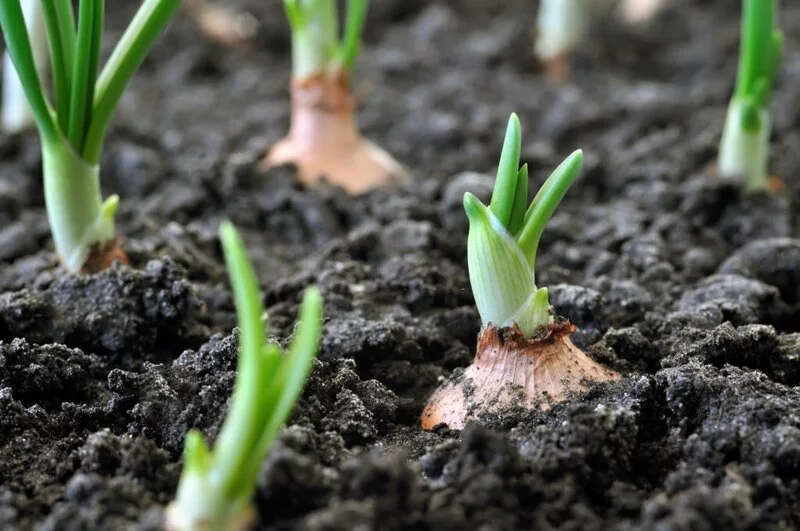Hello, budding botanists and garden gurus! Have you ever sliced into an onion and wondered how this tear-jerker of a vegetable comes to be? Today, we’re going on an underground adventure to explore the fascinating world of onion reproduction. Onions are more than just an essential ingredient in your kitchen; they’re a marvel of nature, reproducing in not just one, but two unique ways. Intrigued? Grab your gardening gloves, and let’s dig into the captivating life cycle of the humble onion.
- Also known as Welsh onions, green onions, Japanese bunching onions, spring onions, and scallions; Perennial plant that produce tasty green stems and tiny white roots
- Winter-hardy, heat-resistant and easy to grow variety; Stems do not have bulbs and are around 6 inches long
- Sow seeds in early spring or later summer; Germination in 10 to 20 days; Harvest in 50-60 days after germination
- All seed counts are approximate due to the small size of the seeds
- Should you have any questions or issues with your order do not hesitate to contact us; We would be happy to help
Onion Life Cycle
Let’s start at the beginning – the life cycle of an onion. Much like a fairytale, the life of an onion has several exciting chapters. It starts with a tiny, dormant seed. Once this seed gets a taste of moisture, warmth, and light, it springs into action, sprouting into a seedling. As this seedling grows, it develops a bulb, that chunky part we’re all familiar with. This bulb then stores enough energy to survive the winter. Come spring, it’s ready to complete its life cycle by producing a flower stalk. This stalk hosts clusters of little white flowers, a kind of grand finale to its life story. These flowers will eventually develop into seeds, starting the cycle all over again.
Sexual Reproduction in Onions
So, how exactly do onions reproduce? Let’s start with sexual reproduction. When the onion plant matures, it produces a flower stalk. These flowers aren’t just there to look pretty; they have a crucial job. Each flower houses male parts called stamens that produce pollen, and a female part called the pistil. When bees or other pollinators visit these flowers, they unknowingly pick up pollen and carry it from one flower to another. This is called pollination. After successful pollination, the magic of life happens. The pollen and the pistil work together to create seeds, each carrying the genetic information from both parent plants. Over time, these seeds mature, and once they’re ready, they drop to the ground, promising the birth of new onion plants in the future. Isn’t that amazing? Who knew the everyday onion could have such an extraordinary life!
Asexual Reproduction in Onions
Now, if you thought onions were done impressing us with their complex sexual reproduction, you’re in for a surprise. Onions have a trick up their sleeve – they can also reproduce asexually. This is nature’s version of making a clone. Instead of going through the pollination and seed formation process, onions can produce new plants directly from the parent bulb.
Here’s how it works: As the onion bulb matures, it can split into separate sections, each capable of growing into a full plant. This is how onion sets – those small, dormant bulbs you might have seen in gardening stores – are formed. Each set is a mini onion, ready to sprout into a full-sized plant, a carbon copy of the parent, no pollination required!
- 🌳 PROFESSIONALLY MIXED IN THE USA – Each bag is hand blended on our small family farm with premium horticultural grade ingredients: Coco Coir, Canadian Peat Moss, Perlite, Worm Castings- 2 QUART BAG
- ✅ PROMOTES RAPID ROOT DEVELOPMENT: With extra perlite and low-salt coconut coir, GARDENERA soil promotes rapid root development .
- 💧 SUPER MOISTURE DRAINAGE- Protects roots by quickly draining away excess water but keeping dirt moist for nutrient retention, best mimics their natural outdoor environment.
- ✅ APPROVED FOR ORGANIC GROWING: All Gardenera Organics premium potting soils are made in the USA 🇺🇸 and contain no additives, proving them great for use in organic growing.
- 🌱 DEVELOPED BY PLANT PARENTS FOR PLANT PARENTS – Crafted specifically to support the growth of Onions. This high quality hand crafted mix is great for Onions. It will allow your plant to grow and become large and healthy.
Cultivating Onions at Home: A Guide to Onion Propagation
Now that we’ve uncovered the mysteries of onion reproduction, how about trying to grow some onions at home? It’s simpler than you might think, and it’s a great way to connect with nature.
Start by choosing the right variety for your climate and season. If you’re a beginner, onion sets are your best bet – they’re easy to handle and grow. Here’s a quick step-by-step guide:
- Choose Your Spot: Onions love the sun, so pick a spot in your garden that gets at least 6 hours of sunlight each day.
- Prepare Your Soil: Onions prefer well-drained soil. Mix in some compost or manure to make the soil nutrient-rich.
- Plant the Sets: Plant the onion sets pointy end up, about an inch deep, and leave about 4 inches between each set.
- Water Well: Keep the soil evenly moist but not waterlogged.
- Harvest Time: When the green tops begin to yellow and fall over, it’s time to harvest your onions!
So there you have it, folks! Onion reproduction demystified and a beginner’s guide to growing your own onions.
- Package contains 4 pounds organic vegetable and tomato fertilizer grains and is produced to avoid wasteful runoff, mess, hazards and smells
- Plant fertilizer is formulated with a 2-5-3 NPK to provide vegetables and tomatoes the nutrients they need to create high yield and vibrant foliage
- Jobe’s organic fertilizer contains no synthetic chemicals and are OMRI listed for organic gardening by the USDA
- Application is simple and should be done every 4-6 weeks or as needed during the growing season
- Jobe’s organic fertilizer is easily measured to provide the right amount of nutrients for vegetable and tomato plants without risk of over fertilizing
Frequently Asked Questions about Onion Reproduction
Now let’s address some of the most common questions that pop up when we talk about onion reproduction.
Can I grow onions from an onion I bought at the store?
Absolutely! If you notice an onion sprouting in your pantry, it’s ready to be planted. Just remember, these are cultivated for eating and might not be as resilient as onion sets specifically grown for planting.
How long does it take for an onion to grow?
Onions usually take between 90-120 days to mature. The exact timing can depend on the specific variety and growing conditions.
Why isn’t my onion producing flowers?
Onion flowering, or “bolting,” typically happens when the plant experiences stress, like sudden temperature changes. If your onion isn’t flowering, it’s probably just too happy and comfortable!
Conclusion
Wow, what a journey we’ve taken, from the mysteries of onion reproduction to how to cultivate them in your backyard! Onions, humble as they may seem, are marvels of nature with their ability to reproduce both sexually and asexually. Understanding their life cycle and reproduction process can make your onion-growing experience even more rewarding. So next time you dice an onion for your dinner, remember you’re holding a tiny miracle of nature in your hands. We hope this has inspired you to look at onions in a new light and perhaps to try your hand at growing some of your own. Happy planting, everyone!







